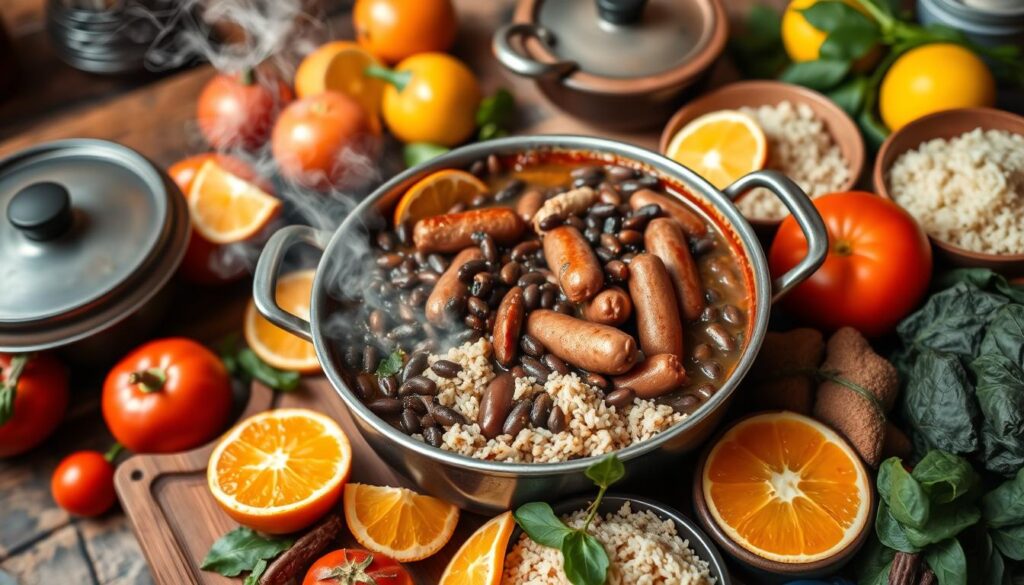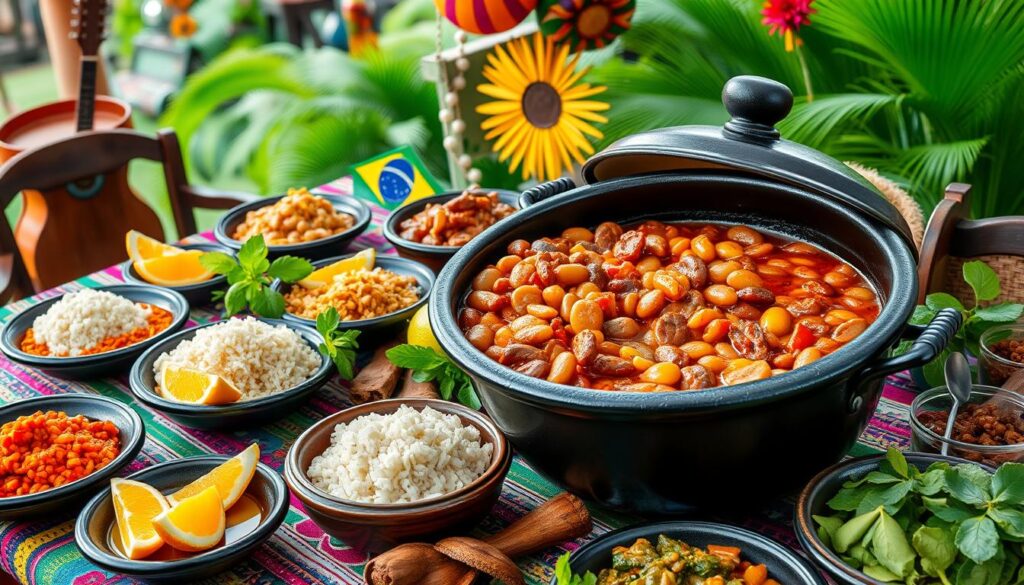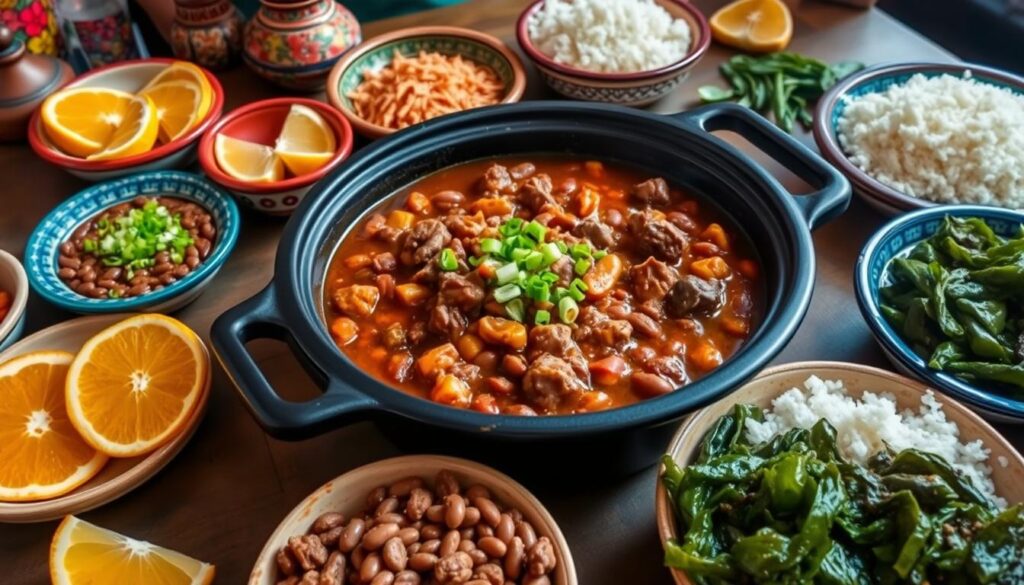Start a journey through Brazilian culture with Feijoada, the ultimate comfort food. This savory black bean stew has become a national treasure. The authentic Brazilian Feijoada recipe combines flavors and ingredients, showing the heart of traditional Brazilian food.
As you cook this dish, get ready for a tasty adventure into Brazilian cuisine. Our guide will help you make an authentic Feijoada. You’ll learn tips to make your cooking better.

Key Takeaways
- Discover how to create an authentic Brazilian Feijoada at home with our complete recipe and step-by-step guide.
- Learn about the rich cultural significance of Feijoada in Brazilian culinary traditions.
- Uncover the history of Feijoada and how it evolved from slave food to a national dish.
- Identify the essential ingredients that lend Feijoada its unique and authentic flavor.
- Gain valuable cooking tips and techniques to ensure your Feijoada is bursting with traditional flavors.
- Explore ideal side dishes and beverage pairings to complement your Feijoada and complete your Brazilian dining experience.
The Cultural Significance of Brazilian Feijoada
Brazilian Feijoada is more than just a meal; it’s a key part of Brazilian culture. It shows the importance of community and celebration in the country. As one of Brazil’s most loved dishes, Feijoada brings together flavors and stories in a shared experience.

This hearty stew, made with black beans and various meats, is a staple on Wednesdays and Saturdays. It brings families and friends together. The history of Brazilian Feijoada goes back to colonial times, showing the mix of indigenous, African, and Portuguese cultures.
Feijoada is a big deal in Brazilian gatherings, from family dinners to big community feasts. It’s not just food; it’s a reason to come together, share stories, and celebrate life. At events like weddings and birthdays, Feijoada is a symbol of unity and celebration.
- Cultural Reflection: Brazilian Feijoada shows the diversity of Brazilian society, blending different ethnic flavors and cooking styles.
- Social Impact: It brings people together, making communal meals a big part of Brazilian culture.
- Symbol of Heritage: Feijoada is seen as a national dish, representing Brazilian identity at home and abroad.
Feijoada is at the heart of Brazilian culture, feeding both the body and the spirit of the community. As a key dish, it stands as a symbol of Brazilian tradition and welcome.
Exploring the Roots: Feijoada History
Feijoada history is deeply woven into Brazilian cuisine. It shows a mix of cultures and traditions. This dish is not just a taste of Brazil but also a story of resilience and cultural integration.
The African Influence on Feijoada
The African influence on Feijoada is clear. African slaves, brought by Portuguese colonizers, brought their cooking traditions. They adapted their methods to local ingredients, creating Feijoada.
This dish started as a survival tool. Now, it’s a national treasure in Brazilian cuisine.
Feijoada in Brazilian Tradition
Feijoada has grown from its humble start to become a key part of Brazilian culture. It’s traditionally served on Saturdays, bringing people together. Each region in Brazil adds its own twist, showing the diversity of Brazilian cuisine.
| Component | Origin | Cultural Significance |
|---|---|---|
| Black Beans | Native to South America | Staple used by many cultures in Brazil |
| Salted Pork and Beef | Influenced by Portuguese colonizers | Represents the adaptation of available resources |
| Feijoada Complete Meal | Evolved in Brazil | Symbolizes the unity in diversity of Brazilian culinary traditions |

Essential Feijoada Ingredients for Authentic Flavor
To make a true black bean stew from Brazil, you need the right ingredients. Feijoada, a traditional dish, is all about the details. From the beans to the meats, each choice is important for the flavor.
Choosing the Right Type of Black Beans
The heart of Feijoada is the black beans. These beans must be able to cook for a long time and soak up flavors well. Look for Brazilian black beans or “turtle beans” for the best taste.
Meats That Make the Dish: Traditional Options
The meats in Feijoada make it special, adding depth to the flavor. It uses pork and beef, including parts that are not usually eaten. This mix of meats gives the stew its unique taste and texture.
- Pork ribs – adds richness
- Smoked sausage – for a deeper flavor
- Dried beef – salted and dried, it enhances the overall savoriness
- Pig’s ears, tail, and feet – add gelatinous body to the broth
| Meat Type | Description | Contribution to Feijoada |
|---|---|---|
| Pork Ribs | Fatty and rich | Richness and depth of flavor |
| Smoked Sausage | Heavily seasoned, smoked | Smokiness and spice |
| Dried Beef | Salted and air-dried | Intense savoriness |
| Pig’s Ears, Tail, Feet | Cartilage-rich, adds texture | Gelatinous body to broth |
How to Cook Feijoada: Step-by-Step Guide
Starting to make Feijoada, Brazil’s famous dish, is both fun and rewarding. Here’s a detailed guide to help you make a real Feijoada in your kitchen. It covers everything from getting ready to serving.
- Ingredients Preparation: First, get all the ingredients ready. You’ll need black beans, smoked meats like pork ribs and sausages, dried beef, bacon, onions, garlic, bay leaves, and orange slices for garnish.
- Meat Preparation: Salt the meats the night before to boost flavor. Rinse them before cooking to remove too much salt.
- Beans Preparation: Soak the black beans overnight to cook them faster and get the right texture. Drain and rinse them before cooking.
- Cooking the Meats: In a big pot, cook the bacon until it’s crispy. Then, sauté onions and garlic until they’re golden. Add the meats one by one, starting with the longest-cooking ones like beef and pork ribs.
- Adding the Beans: Put the soaked black beans in the pot, then add enough water to cover everything. Add bay leaves for extra flavor.
- Simmering: Let it simmer on low heat for hours, stirring and adding water as needed. You want the beans and meats to be tender and full of flavor.
- Final Seasoning: Season with salt and pepper to taste. Add chopped coriander for a fresh touch before turning off the heat.
- Serving: Serve hot with white rice, orange slices, and stir-fried collard greens. Don’t forget to sprinkle farofa (toasted cassava flour) on top for extra texture.
This guide takes you through the rich flavors and cultural traditions of Brazilian cuisine. It’s perfect for both experienced cooks and beginners. Learning to make Feijoada brings a piece of Brazil into your kitchen.
Making the Perfect Feijoada: Cooking Techniques and Tips
Learning how to cook Feijoada is more than just mixing ingredients. It’s an art in traditional Brazilian food. This section shares cooking techniques and Feijoada tips from Brazilian culinary experts. These tips improve flavor and texture.
Getting the cooking time right is key. Beans should be tender but not mushy. Meats must be cooked well to add flavor without drying out. Here are expert tips for the perfect taste and texture:
- Start with pre-soaked black beans to shorten the cooking time and ensure even cooking.
- Use a mix of meats, including smoked sausages and sun-dried beef; the variety adds depth to the dish’s flavor.
- Cook over low heat: An essential tip in Feijoada tips is the slow cooking process. A low and prolonged simmer helps the flavors meld together perfectly.
- Season sparingly at initial stages; adjust salt and spices after the meats are thoroughly cooked, as these ingredients can alter flavor absorption.
The broth’s consistency is crucial. It should be rich and moderately thick. Here’s how you can achieve it:
- Once the beans are tender, remove a cup of beans and mash them before returning them to the pot. This naturally thickens the broth without the use of flour or cornstarch.
- Adjust the broth’s thickness to your preference by controlling the cooking time. Simmer uncovered to reduce the broth or add water to thin it slightly.
Feijoada tastes best when flavors have time to meld. It’s perfect to prepare a day ahead. This allows the rich, spicy, and smoky flavors to deepen, enhancing the dish’s delight.
By following these detailed techniques, any aspiring chef can make a delicious Feijoada. It captures the essence of Brazilian culinary tradition. Happy cooking!
How to Make Authentic Brazilian Feijoada: Complete Recipe and Tips
Learning to make Brazilian Feijoada is all about mastering key steps. This guide covers the basics to achieve a rich flavor, central to this beloved dish in Brazilian cuisine.
Soaking the Beans: Pre-Cooking Prep
Start by picking top-quality black beans for your authentic Brazilian Feijoada. Soaking them overnight makes them soft and helps them cook evenly. Use plenty of cold water to cover them, as they swell a lot.
Layering the Flavors: Cooking Sequence
Building the flavor base is key in Brazilian cuisine, especially for Feijoada. Begin by sautéing onions and garlic until they’re clear. Then, add smoked meats like sausages and pork ribs. Let them brown a bit before adding the soaked and drained beans.
Cover everything with fresh water, bring to a boil, then simmer. Skim off any foam that forms. Season with salt and pepper towards the end to taste.
The secret to a true Brazilian Feijoada is in the simmering. It’s where all the ingredients blend together slowly. This slow cooking lets each ingredient release its flavors, creating a rich, deep taste that’s the dish’s hallmark.
Side Dishes to Complement Your Feijoada
Enjoying Brazilian Feijoada is best with a variety of side dishes. These sides offer a delightful contrast and balance the rich flavors of the dish. Here’s a guide to the quintessential side dishes that complete this culinary experience.
- Rice: A staple in Brazilian cuisine, fluffy steamed rice acts as the perfect base to absorb the flavors of the feijoada.
- Collard greens: Sliced and sautéed with garlic, these greens add a touch of bitterness that complements the meaty richness.
- Farofa: Toasted cassava flour cooked with butter, salt, and bits of bacon, provides a crunchy texture to the meal.
- Orange slices: Fresh orange slices are served to cleanse the palate and cut through the fat of the meats.
When talking about Brazilian Feijoada, its classic side dishes are essential. Each component complements the taste and enhances the dining experience. From the creamy rice to the refreshing orange slices, these sides make the meal complete.
Brazilian Food Pairing: Beverages to Serve with Feijoada
When it comes to Brazilian food pairing, finding the perfect beverages to serve with Feijoada is key. This part explores traditional Brazilian cocktails and fun, non-alcoholic drinks. These options make any meal special.
Traditional Brazilian Cocktails
Feijoada goes great with many Brazilian cocktails. The Caipirinha is a top choice. It’s made with cachaça, sugar, and lime. Its sweet and tangy taste balances the Feijoada’s richness.
- Caipirinha: Lime, sugar, and cachaça.
- Batida: A fruity cocktail blending cachaça with coconut milk, sugar, and various fruits like passion fruit or guava.
- Rabo de Galo: Cachaça mixed with red vermouth, a strong and aromatic companion to Feijoada.
Non-Alcoholic Options for Everyone
For a family-friendly meal, non-alcoholic drinks are a must. Traditional Brazilian fruit juices and coconut water are perfect choices.
- Coconut Water: Offers a fresh, light taste that complements spicy or salty flavors.
- Guarana Antarctica: A popular Brazilian soda with a unique apple-berry flavor.
- Fruit Juices: Mango juice or passion fruit juice for a tropical twist that echoes the lush Brazilian landscapes.
The table below shows great pairings for a menu that honors Brazilian tradition. It also meets everyone’s tastes:
| Beverage Type | Description | Best Served With |
|---|---|---|
| Caipirinha | Lime, sugar, and cachaça. | Traditional pork and bean Feijoada |
| Batida (various flavors) | Fruity cachaça-based cocktail. | Feijoada variations with lighter meats like chicken or turkey |
| Coconut Water | Pure and refreshing hydration. | Hearty meat-heavy dishes |
Feijoada Tips: How to Serve and Enjoy
Mastering Brazilian cuisine means knowing how to prepare and present dishes like Feijoada. Here are some Feijoada tips to make your dish taste great and look beautiful. This will make your meal unforgettable.
- Choose the Right Vessels: Use earthenware or colorful ceramic pots for Feijoada. They keep the dish warm and add to its rustic charm.
- Presentation: Add orange slices and chopped parsley on top. They bring color and a fresh scent that goes well with the dish’s rich flavors.
- Accompaniments: Serve with white rice, collard greens, and toasted cassava flour (farofa). This offers a full and balanced meal.
To be a great host at a Feijoada feast, follow these cultural tips important for Brazilian cuisine.
- Feijoada is best served at noon or for late lunch, as it’s traditional in Brazil.
- Let guests serve themselves. This lets them pick their favorite meat, adding to the dish’s communal spirit.
- For a true Brazilian touch, serve caipirinha cocktails or Brazilian beers. They pair perfectly with Feijoada.
Knowing how to pace the meal is key to a successful Feijoada event:
| Course | Description | Recommended Time |
|---|---|---|
| Starter | Light salad or fried appetizers | 15 mins before Feijoada |
| Main | Feijoada served with rice, greens, and farofa | Main meal time |
| Dessert | Simple Brazilian dessert like passion fruit mousse | 30 mins after main |
The secret to serving Feijoada well is not just in how it looks. It’s also about how it’s shared and enjoyed. Follow these Feijoada tips for a truly authentic and enjoyable Brazilian meal.
Storing and Reheating: Keeping Your Feijoada Tasting Great
Feijoada, a hearty stew from Brazil, is loved for its rich flavors and the joy it brings when shared. It’s often made in big batches, leaving leftovers that can last for days. To keep your Feijoada tasting as good as the first time, it’s important to know how to store and reheat it right. This ensures the dish stays safe and its flavors and textures stay intact.
Best Practices for Storing Leftover Feijoada
First, cool the Feijoada down fast. Split it into smaller, shallow containers to speed up cooling and prevent bacteria. Put it in the fridge within two hours of cooking. It will stay fresh for up to three days. For longer storage, freezing is a good choice. Use an airtight container or freezer bag, leaving some space at the top for expansion.
Reheating Feijoada without Losing Flavor
When reheating Feijoada, do it right to keep the flavors and texture. If it’s been in the fridge, warm it up in a pot over low heat, stirring now and then. If it’s frozen, thaw it in the fridge overnight before reheating. Always heat it to 165°F (74°C) to make sure it’s hot all the way through. By following these steps, you’ll enjoy the delicious flavors of Feijoada every time you eat it.
FAQ
What is Brazilian Feijoada?
Brazilian Feijoada is a savory black bean stew. It’s a key dish in Brazilian cuisine. It’s made with meats like pork and beef, giving it a rich flavor.
Feijoada is loved across Brazil. It’s enjoyed at family gatherings and social events. Each region has its own twist on the dish.
What are the origins of Feijoada?
Feijoada’s history goes back to Brazil’s colonial days. It was influenced by African cuisine. African slaves made it with black beans and pork, using what they had.
Over time, it became a beloved national dish. It’s cherished in Brazilian society.
What ingredients do I need for an authentic Feijoada?
For real Feijoada, you need black beans and salted pork products. This includes pork ribs, feet, ears, and tail. Smoked meats, beef, and sausages like Brazilian chorizo are also key.
Onions, garlic, and bay leaves add to the flavor. But, ingredients can change based on where you are in Brazil.
How do I cook Feijoada?
Start by soaking black beans overnight. Prep the meats, soaking them to reduce saltiness. Then, cook the beans and meats together with aromatics.
This slow cooking process makes the flavors rich and complex. There’s a special order to adding ingredients.
Are there any special side dishes to serve with Feijoada?
Yes, serve Feijoada with white rice, collard greens, orange slices, and farofa. Farofa is toasted cassava flour. These sides balance the dish’s rich flavor.
What beverages pair well with Feijoada?
A caipirinha, a Brazilian cocktail, pairs well with Feijoada. Its citrus notes cut through the dish’s richness. Brazilian beers and red wines also work well.
For non-alcoholic options, try fresh orange juice or tropical fruit punches.
How should Feijoada be served?
Serve Feijoada family-style in large pots. This highlights the meal’s communal nature. Place each side dish in separate bowls for guests to customize their plates.
Enjoy it during leisurely meals. This way, diners can savor the flavors and textures at their own pace.
What’s the best way to store and reheat leftover Feijoada?
Store leftover Feijoada in airtight containers in the fridge. Eat it within 3 to 4 days. When reheating, use a little water to keep it moist.
Reheat it gently on the stovetop or in the microwave. This helps preserve its flavor and texture.
Can Feijoada be made in advance?
Yes, Feijoada tastes better the next day. The flavors meld together more. Just follow proper storage and reheating to keep it delicious.
Is there a vegetarian version of Feijoada?
Traditional Feijoada is meat-heavy, but there are vegetarian versions. These use tofu, tempeh, or smoked vegetarian sausages. Smoked paprika adds a smoky flavor.








